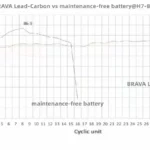Battery Maintenance Guide
Thank you for selecting Brava Battery as the power source for your equipment. For over 10+ years, Brava Battery has set the standard for Genuine Gel Technology and AGM batteries used in power mobility devices which is why leading manufacturers, worldwide, trust Brava as their source for powering their wheelchairs and scooters. This Guide will help you maximize your battery’s performance for long-life, safety and peace of mind.
Battery Installation
- Always have your batteries installed by a properly trained wheelchair or scooter technician. They have the necessary training and tools to do the job safely and correctly.
- Wheelchairs and scooters typically require two batteries with a 24-volt series connection. Never mix and match different battery manufacturers, sizes or technologies, or use batteries that do not have similar date codes. Never mix Gel batteries with AGM batteries.
- Always fully charge batteries prior to use.
- Follow installation and start-up instructions provided by the mobility equipment manufacturer.
Brava Genuine Gel Break-In Period
Active users of power wheelchairs cycle their batteries daily (deep cycling). This stringent application requires a unique battery design that will sometimes compromise initial capacity in return for longer battery life.
Brava Gel battery performance improves once the battery has been cycled (discharged and recharged) 15-20 times. This break-in period is necessary to fully activate the battery for maximum performance and
longevity. Thus, range and running time of your mobility device will increase with use during the break-in period.
When to Charge Battery?
- Charge daily and for as long as possible, even on days with low usage.
- The charger supplied with your mobility equipment should fully charge your batteries overnight. Overcharging is not a problem with today’s smart chargers as they are voltage limited and shut off automatically.
- Chronic undercharging is a common cause of sulfation which can reduce capacity, shorten run times, and lead to premature battery failure. Daily charging for the longest amount of consecutive hours
possible is required. Minimum charge time of 8 hours is recommended to return 80% of the capacity of the battery. To return 100% of the battery’s capacity, additional charge time may be required. To regain lost capacity due to chronic undercharging and to enhance battery life, it is recommended that a 12-hour charge be performed at least once each week.
Proper Charging Guidelines
- Use the equipment manufacturer’s automatic charger for all routine charging.
- Never use an automotive trickle type or wet type charger on Sealed VRLA Gel or AGM batteries as doing so will damage your batteries.
- The harder a battery has to work, the shorter its life expectancy. Longer use typically means longer recharge times.
- Avoid ultra-deep discharges and never drain your batteries completely. Draining your batteries completely may result in your charger not being able to charge your batteries.
- Charge your batteries immediately after use. If unable to charge immediately, do not leave your batteries in a discharged state for more than 24 hours. Batteries should be charged daily to a full state of charge regardless of the amount of time the batteries are used.
- We recommend the following guidelines for charging. Use a 2 amp charger for batteries between 7-18 ah. Use a 5 amp charger for batteries between 20-45 ah.
Use an 8 amp charger for batteries between 50-79 ah. See the below table.
Battery Storage and Maintenance
- Always store your batteries FULLY CHARGED.
- Charge once a month while in storage with the equipmentmanufacturer’s charger for a minimum of 24 hours.
- Avoid hot and cold extremes when storing.
- Sealed VRLA Gel and AGM batteries require no watering.
- Any performance related issues should be handled by a properly trained wheelchair or scooter technician.
Safety
- Dropping a tool or touching a watch or bracelet across the terminals can result in an electrical shock, sparks, smoke, fire and even an explosion. Use extreme caution around exposed battery terminals.
- Battery posts, terminals and related accessories contain lead and lead compounds, and other chemicals known to the state of California to cause cancer and birth defects or other reproductive harm. Wash hands after handling.
- BE CAREFUL! Batteries produce explosive gases. Keep sparks, flames and cigarettes away from batteries at all times. ALWAYS wear safety glasses and a face shield when working on or near batteries. Ventilate well. Do not install in an airtight container.
- DO NOT ATTEMPT TO OPEN THE VENTS ON TOP OF THE BATTERY.
- All old batteries are considered “hazardous material” and must be recycled through an approved agency to prevent improper disposal. Lead-acid batteries are virtually 100% recyclable. Be sure to return your used lead-acid batteries to a retailer. In most areas it is illegal to discard such a battery in the trash.
There’s Only One Place To Buy Batteries For Your Mobility Equipment.
Brava Batteries are sold exclusively through Home Medical Equipment suppliers. Brava does not sell direct to consumers because the best sources for your batteries are the well-trained wheelchair technicians
at your local dealer. They understand your mobility equipment inside and out, know which batteries best fit your specific needs, and can most accurately determine when and if battery replacement is necessary.
For quality Brava Battery products and peak performance, visit your local authorized retailer.
Manual Download: Battery maintenance guide
AGM Batteries Related Products:
Related Products Application:
AGM Batteries Related Posts:
Tag in this article: #Battery
Tips: more detail information, for acid battery。






















